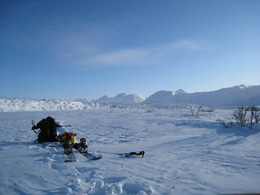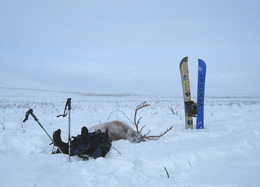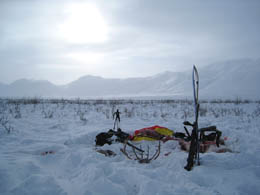Alaska Fish & Wildlife News
January 2013
Winter Caribou Hunt: Skiing off the Dalton Highway
Lessons, Offerings, and Rewards in the DHCMA

As I ski into the herd, the caribou dart in all directions, hundreds of them, their hooves clicking like music from a tribal dance. The sky is clear; the wind is calm. The only sounds I hear are the rumble of caribou hooves across the snow and the swooshing of my skis gliding along. I stop and watch them run for a moment.
I am in Alaska’s Brooks Range near Atigun Pass. I am here to hunt caribou in Alaska Game Management Unit 25A. I have only traveled about one quarter of a mile from the Dalton Highway and already I am surrounded by caribou. It is the first week of March. There are no other hunters and no snow machines. The only trace of civilization is the occasional “ice road trucker” blazing down the highway. A hunting opportunity such as this one, with plentiful game, solitude, and relatively easy, non-assisted access is a gift to a modern hunter. That gift comes with a price however: to legally hunt caribou with a rifle a hunter must be outside of the Dalton Highway Corridor Management Area (DHCMA), which extends for five miles on each side of the Dalton Highway[1]. Motorized access for hunting, from the road to areas outside the 5 mile corridor, is not allowed. Accordingly, there is no need to buy an expensive machine for this hunt. You also don’t need to win the Draw to participate, but you will need strong legs, physical fortitude, and a caribou Harvest Ticket.
As I ski onward my expedition sized pack begins to burn my shoulders. On this great tundra, in the valleys of these pure white mountains, route finding should be simple. However, I seem to narrowly escape the dangers of overflow ice numerous times. In a frozen world who would expect open water to suddenly arise from under the sheets of ice and drench one’s boots, freezing them solid in milliseconds? I need to be more careful; such a mistake in this place could mean frostbite, amputation, or even death.
I am two miles inside the DHCMA and the caribou remain abundant. I contemplate the awkwardness of not taking advantage of the opportunity to make a quick kill, of being a hunter so close to my quarry, having dozens of animals all within easy range, of being within close reach of a truck on the road and thus not facing an extremely arduous meat haul following my harvest. But I also contemplate the rewards of being with the caribou, of traveling amongst them and getting to know them, of disciplining myself to wait. I continue further inside the DHCMA another mile. The caribou are still here in places, they are more dispersed now. I contemplate the possibility that there will be no caribou outside the 5 mile corridor.
As I reach the three and a half mile mark the light begins to fade over the western horizon and a deep chill is beginning to set in all around me. While digging snow to establish a tent space, the unmistakable howl of wolves erupts from the mountainsides. The tonal atmosphere sends a chill through my body that overcomes the chill of the cold. For thousands of years humans across the north likely heard this song as they settled into their evening camps. Until very recently, wolves have always walked in the shadow of the hunter. In many parts of Alaska they still do, especially during caribou hunting trips like this one into the Brooks Range.
In the twilight I scan the moraines with my binoculars. I discover that within a half mile of my camp a pack of wolves has bedded down for the night. For several moments I watch them sing. As I crawl into my sleeping bag I feel quite vulnerable, alone in the Arctic, sub-zero temperatures, and darkness, surrounded by one of the most storied predators on earth. Nevertheless I am very happy to be where I am. A recollection of history and ecology calms my nerves, for the wolves and I are united in this place at this cycle of the seasons for the same purpose.
It is the following day and I have skied a few more miles up the valley and crossed the DHCMA boundary. In the distance I can make out a small herd of caribou on the lower reaches of a south facing slope. I ascend cautiously and quietly, attempting to find cover in small ravines and behind rises of willow. With senses evolved through thousands of years of being preyed upon by wolves, these animals, who are in tune to the slightest movement in the distance, will not fail to sense my presence for long. Abruptly the dark spots of tundra begin to move like an ocean wave across the expanse. In retreat the caribou disappear behind a small rise further in the distance. The window has been opened.
I need to travel fast over considerable distance. I am pushing my skis as hard as I can through collapsing sugar snow on top of dense willow brush. Movement is slow and demanding, yet this is the moment for action. The quick sprint of the hunter that evolved in our genes on the African savannahs is the necessary movement. However I lack the advantage of being born into such a practice and the first great lesson of survival for me on this journey sets in: hesitation now means failure, and in the wild world failure has high consequences. Gasping for breath I reach the rise, my heart beating like the drums of a thousand caribou hooves pounding at light speed across the Arctic tundra. They sense my presence immediately. Some of them disperse further away. A small group cuts back around. A curious bull stops to analyze me for a moment and then turns to follow his group, a group whose trajectory leads back in the direction I have traveled from and likely will cross in front of me. I kneel, uncomfortably stretching the toe pins linking my feet to my skis. I carefully place my rifle on the cross beam of my shooting sticks, partially stabilizing my nervous and shaking limbs. As the group reappears, now trotting broadside directly across from me, I lean into the scope on my rifle. They are moving quickly; time is short. Holding the scope steady, I watch the opportunity wane as the last of the group begins to fall behind another rise. Suddenly the curious bull stops and looks back towards me. Click. He is down.

Allowing the adrenaline to subside for a moment, I ski slowly towards the bull. I reach him and dismount from my skis. I kneel beside him and offer words of gratitude for the gift he has given me. As I begin the butchering process I look across the valley to see a black wolf skirting the hillside across from me. Every so often the wolf stops to glance in my direction, likely in eager anticipation of the gift I will leave her upon my departure. The sun begins its descent and it feels as if I am taking much too long to accomplish the task at hand. I am unnerved that the wolves are watching me. I am wary that they may visit prematurely or follow my meat to camp. I carefully place the severed portions of caribou in the packable rescue sled I carry in my pack. My hands are numb from exposure to sub-zero temperatures. The warm blood soaks my gloves and then freezes instantly. I need to move on. I secure the antlers to my pack. I finish off the last of my water that is not frozen solid and begin the laborious haul back towards my camp.
I must be dragging well over one hundred pounds on my hips. The sled sinks deep into pockets of twisted willow strewn sugar snow. The skins on my skis are the only thing giving me the leverage to drag the weight. For almost three miles it goes like this: four to six steps of immense physical fortitude, a sixty second rest, and repeat, on and on, my only relief coming from the few sections of exposed surface ice on the river bottom that allow the sled to glide. This is one of the most difficult things I have ever done and I have nearly reached my physical limit. The sun is on the downside of the horizon. The temperature is rapidly dropping. I am cold, thirsty, hungry, tired. I must reach camp. It has become a true matter of life and death. I will not leave the meat.
Just as darkness falls I reach the outskirts of my camp. The wolves begin their nightly howling ritual. I have a deep feeling of unease. Will they come for the meat? One-hundred yards out I bury the caribou in snow and cover it with willow branches. I go straight for my stove. I desperately need hot water and food. A meal accomplished, I begin to melt snow to fill my water bottles. The stove sputters and dies. I failed to anticipate the high amount of fuel required to make water at these temperatures. I can make it through the night but tomorrow I will be in trouble. The resources for fire in this place are scarce. Everything is for the moment now. I am in a physical and psychological realm I have never before experienced: gaining a newfound understanding of what it means to be on the threshold of survival. Without my sleeping bag I would surely perish within a few hours at best. I shed my outerwear, stuff my frozen gloves, socks, and half bottle of water in my sleeping bag and climb in. Slowly the warmth comes back and I take a moment to consider my predicament and formulate a plan to get myself out of it.
There is no way I can manage getting the meat and my entire camp out in one haul. The meat is my priority. I will not leave it. If I abandoned it, taking this animal would be pointless. Thus, in the morning I will pack only the bare necessities and the sled full of meat to the road. The next day I will return for the second haul. Somehow I will get water or fuel on the road. I might be able to flag down a passing “ice road trucker” and obtain supplies. This is the best plan I can think of. But first I must make it through the night.
Soon after I doze off but then awake shivering. My toes are numb and feeling seems unrecoverable. My nose and face are in a similar predicament. My -20 F down bag is failing me. The wind is blowing my tent around. I am covered in the smell of fresh blood. “You are really on the edge now” I say to myself.

First light brings the immense joy that night has passed. My situation has brightened. Although it stormed overnight, filling in my original ski trail with snow, today the sky is once again clear. The sun will make the difference in my attitude, providing needed warmth and visibility. I quickly pack up and begin hauling the meat sled. It is far and travel is difficult. I am forced to make a new trail through fresh snow and the weight being carried is immense. When I finally reach the road my physical reserves are zapped. Past prudence produces the spare sleeping bag I keep in my truck and unleaded fuel burns decently in my stove. For now I am safe and the meat is secure. After another cold night I arise anxious for a ski to retrieve my camp.
I arise to a new storm with the potential for whiteout conditions. I stumble out of my sleeping bag to investigate and find that yesterday’s ski trail is still in. If I hurry I will be able to follow it to camp. I race across the valley and reach my camp. The storm begins to clear. I pack up camp and by evening I have hauled all of my gear to the road. The feeling of relief is immense, the feeling of accomplishment, of gaining newfound experiential knowledge, is surreal. For thousands of year’s indigenous people in the far north survived on caribou meat in the Arctic. They did so without firearms, modern camping gear, and fuel powered cook stoves. I now have a deeper understanding of what this type of lifestyle would have entailed. I also have a renewed supply of wild protein to fill my freezer. The flesh of this creature will power me on journeys to come over the course of the approaching spring. I can’t think of a healthier or more connected way to eat than this and I will remember the life of this animal and my struggle to take that life with every meal over the coming months.
More about Hunting inside and outside of the DHCMA
The DHCMA provides great benefits to hunters in the State of Alaska. It provides wildlife conservation along the easily accessible Alaska road system while simultaneously providing amazing hunting opportunities. Dedicated archery hunters and rifle hunters, who are up for a long walk and the responsibility that comes with it, have ample opportunity to hunt big game here. Archery hunters have five miles on both sides of the Dalton Highway to themselves for 347 miles, from the Yukon River Bridge to the Prudhoe Bay Closed Area boundary 24 miles south of the Arctic Ocean (beyond which big game hunting is closed) [2]. Beyond the five mile DHCMA corridor, rifle hunters have access to wildness ad infinitum. Providing that hunters coming from locations to the south can afford to make the long drive up into the far north, the resources required to hunt are minimal: a finely tuned weapon, adequate clothing, camping gear, solid wilderness skills, and a moose, bear, caribou, or sheep Harvest Ticket are all that is needed. Draw Permits, OHVs, trailers, and airplane rides are not necessary here and that is important for hunters not lucky enough to win the lottery, who are low on cash, or who just want the opportunity to hunt in peace and solitude.
My number one recommendation for rifle hunters interested in traveling beyond the five mile DHCMA is to hunt with friends. Avoid hunting alone. Part of my reason for telling the story here about my winter solo hunt is to provide inspiration to others and to caution them about the risks. Based on my experience, I personally would not hunt solo beyond the DHCMA again, winter or summer. Successfully harvesting an animal means taking on the responsibility of hauling all of the meat out. I suggest hunting on skis with a sled (or with a dogsled) during snow covered months in order to facilitate efficient transport. Being able to slide on snow saves lots of time and valuable energy. When you go in as a group only harvest what the entire group can haul out safely and in a timely manner.
Another reason I choose to write this story is to bolster the importance of the DHCMA for Alaska. The DHCMA is a place not to be taken for granted: in terms of the access to hunting opportunities it provides, in terms of the ethics and dedication to hard work required to hunt there, and also in terms of its contribution to Alaska’s conservation heritage.
[1] Archery hunting is allowed within the DHCMA.
[2] Regulations may differ on federal lands.
James Van Lanen is a Subsistence Resource Specialist for ADF&G Division of Subsistence, currently based in Anchorage.
Subscribe to be notified about new issues
Receive a monthly notice about new issues and articles.
